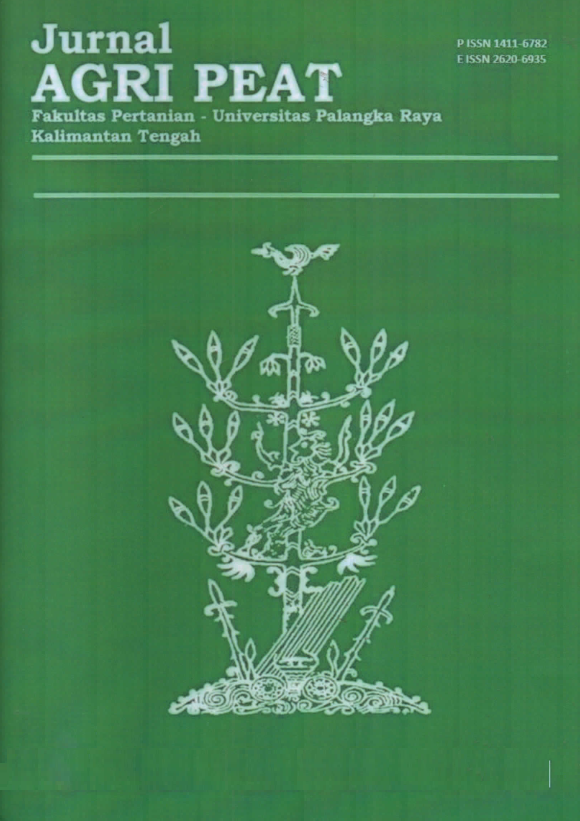PENGARUH JARAK DARI SALURAN DRAINASE TERHADAP FLUKTUASI MUKA AIR TANAH DAN SIFAT FISIK TANAH GAMBUT PEDALAMAN DI TUMBANG NUSA - KALIMANTAN TENGAH
THE IMPACT OF DISTANCE FROM DRAINAGE CHANNELS ON GROUNDWATER LEVEL FLUCTUATIONS AND PHYSICAL PROPERTIES OF INLAND PEAT SOILS IN TUMBANG NUSA, CENTRAL KALIMANTAN
DOI:
https://doi.org/10.36873/agp.v25i01.12603Keywords:
Peat soil, water table, physical properties, land use, drainage canal, environmental factorsAbstract
Indonesia is a country that has the largest peat area in the tropics, estimated at 21 million ha. This research aims to determine the effect of the distance from the drainage channel on fluctuations in groundwater levels (water table) and physical properties of peat soil in different land cover conditions with open land planted with Rambutan trees (N. lappaceum) and bush land growing ferns (Pteridophyta) and Bajakah. (S. littoralis). This research was carried out from August to October 2023 in Tumbang Nusa Village, Jabiren Raya Subdistrict, Pulang Pisau Regency, Central Kalimantan Province and the UPT. LLG-CIMTROP Laboratory, University of Palangka Raya. Firstly take n 1 (one) whole soil sample (undisturb) and taken ± 1 kg by using a ring with a depth of 0-20 cm and measure the physical properties of the soil 4 (four) times, once every 2 (two) weeks at each sampling point peat. The method used in the research is purposive sampling, namely a sampling method with certain considerations in 4 (four) plots each with different land cover. Data is processed using Microsoft Excel 2021 for Windows which will be presented in the form of tables and graphs. The results of groundwater level measurements in the field show a weak relationship, a very weak relationship and a fairly strong relationship between the physical properties of peat soil in different land cover conditions. The relationship between ground water level (water table) and volumetric weight, water content and temperature are cubic and positive. The relationship between ground water level (water table) and particle density and humidity in different land conditions shows a negative cubic relationship. From testing the soil properties, the cumulative effect is volume weight (bulk density), temperature and water content, where the R2 value for volume weight is 0,4518 and temperature is 0,56. Then the water table is influenced by the distance from drainage canal.
Keywords: Peat soil, water table, physical properties, land use, drainage canal, and environmental factors
Downloads
References
Adinugroho, W. C., I N.N. Suryadiputra, Bambang Hero Saharjo dan Labueni Siboro, 2004. Panduan Pengendalian Kebakaran Hutan dan Lahan Gambut. Bogor: Wetlands International
Agus F. Hairiah, K dan Mulyani, A. 2011. Petunjuk Teknis: Pengukuran Cadangan Karbon Tanah Gambut. Balai Penelitian Tanah. Bogor.
Agus, F. dan I. G. M. Subiksa. 2018. Lahan Gambut: Potensi untuk Pertanian dan Aspek Lingkungan. Booklet. Balai Penelitian Tanah dan World Agroforestry Center (ICRAF) Southeast Asia, Bogor.
A'idah, E., Destiarti, L. dan Idiawati, N. 2018. Penentuan karakteristik air gambut di Kota Pontianak dan Kabupaten Kuburaya. Jurnal Kimia Khatulistiwa, 7(3).
Andriesse, J.P., 1988. “Nature and Management of Tropical Peat Soils.” Food and Agriculture Organization of the United Nations Soils Bulletin no. 59. FAO.
Azri. 1999. Sifat kering Tidak Balik Tanah Gambut dari Jambi dan Kalimantan Tengah: Analisis Berdasarkan Kadar Air Kritis, Kemasaman Total, Gugus Fungsional COOH dan OH-Phenolat. Pogram Pascasarjana. Institut Pertanian Bogor.76 hal.
Balai Besar Penelitian dan Pengembanagan Sumberdaya Lahan dan Pertanian (BBSDLP), 2019. Inovasi Teknologi Sumberdaya Lahan Untuk Pertanian Berkelanjutan, Kementrian Pertanian, Bogor.
Batubara, S. F. 2009. Pendugaan Cadangan Karbon dan Emisi Gas Rumah Kaca pada Tanah Gambut di Hutan dan Semak Belukar yang Telah di Drainase. Pogram Pascasarjana. Institut Pertanian Bogor.
Darbin Simatupang, Dwi Astiani dan Tri Widiastuti, 2018. Pengaruh Tinggi Muka Air Tanah Terhadap Beberapa Sifat Fisik Dan Kimia Tanah Gambut Di Desa Kuala Dua Kabupaten Kubu Raya. Jurnal Hutan Lestari.Vol. 6 (4) : 988 – 1008.
Duwi Priyatno. 2014. Mandiri Belajar Analisis Data dengan SPSS. Yogyakarta: Mediakom.
Hardjowigeno. S. 1986. Sumber Daya Fisik Wilayah dan Tata Guna Lahan Histosol. Fakultas Pertanian Institut Pertanian Bogor.
Hardjowigeno, S. 1989. Sifat dan Potensi Tanah Gambut Sumatera untuk Pengembangan Pertanian. Prosiding Seminar Tanah Gambut untuk Perluasan Pertanian. Fakultas Pertanian UISU. Medan. Hal 43-79.
Ramadhan, S., F. H. Yusran., A. Haris dan S. Asmawi. 2013. Pengaruh pembakaran gambut terhadap gugus fungsional organik yang dihubungkan dengan kadar air gambut. EnviroScienteae, 9(1): 129-140.
Riduwan dan Sunarto. 2007. Pengantar Statistika. Bandung: CV Alfabeta.
Situmorang, P. C. 2015. Pengaruh Kedalaman Muka Air Tanah dan Mulsa Organik terhadap Sifat Fisik dan Kimia Tanah Gambut pada Perkebunan Kelapa Sawit (Elaeis guineensis Jacq). Universitas Riau. Pekanbaru.
Wahyunto dan I.G.M. Subiksa. 2011. Pengelolaan Lahan Gambut Indonesia. Balai Penelitian Tanah. Bogor.
Winarna. 2015. Pengaruh Kedalaman Muka Air Terhadap HidrofobisitasTanah. Gambut, Emisi Karbon, dan Produksi Kelapa Sawit. Disertasi. Institut. Pertanian Bogor.
Downloads
Published
Issue
Section
License
Copyright (c) 2024 AgriPeat

This work is licensed under a Creative Commons Attribution-NonCommercial-ShareAlike 4.0 International License.












